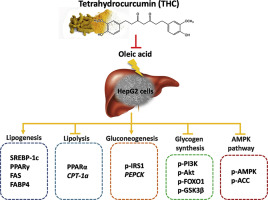当前位置:
X-MOL 学术
›
J. Food Drug Anal.
›
论文详情
Our official English website, www.x-mol.net, welcomes your feedback! (Note: you will need to create a separate account there.)
Tetrahydrocurcumin ameliorates free fatty acid-induced hepatic steatosis and improves insulin resistance in HepG2 cells
Journal of Food and Drug Analysis ( IF 3.6 ) Pub Date : 2018-07-01 , DOI: 10.1016/j.jfda.2018.01.005 Jin-Wun Chen , Zwe-Ling Kong , Mei-Ling Tsai , Chih-Yu Lo , Chi-Tang Ho , Ching-Shu Lai
Journal of Food and Drug Analysis ( IF 3.6 ) Pub Date : 2018-07-01 , DOI: 10.1016/j.jfda.2018.01.005 Jin-Wun Chen , Zwe-Ling Kong , Mei-Ling Tsai , Chih-Yu Lo , Chi-Tang Ho , Ching-Shu Lai

|
Elevated levels of free fatty acids (FFAs) in the liver, resulting from either increased lipolysis or imbalanced FFAs flux, is a key pathogenic factor of hepatic steatosis. This study was conducted to examine the therapeutic effect of tetrahydrocurcumin (THC), a naturally occurring curcuminoid and a metabolite of curcumin, on oleic acid (OA)-induced steatosis in human hepatocellular carcinoma cells and to elucidate the underlying mechanism. HepG2 cells were incubated with OA to induce steatosis, and then treated with various concentrations of THC. The results showed that THC treatment significantly decreased lipid accumulation in OA-treated HepG2 cells, possibly, by inhibiting the expression of the lipogenic proteins, sterol regulatory element-binding protein 1 (SREBP-1c), peroxisome proliferator-activated receptor gamma (PPARγ), fatty acid synthase (FAS), and fatty acid-binding protein 4 (FABP4). Moreover, THC attenuated OA-induced hepatic lipogenesis in an adenosine monophosphate-activated protein kinase (AMPK)-dependent manner, which was reversed by pretreatment with an AMPK inhibitor. THC promoted lipolysis and upregulated the expression of genes involved in β-oxidation. Glucose uptake and insulin signaling impaired in HepG2 cells incubated with OA were abated by THC treatment, including phosphorylation of the insulin receptor substrate 1 (IRS-1)/phosphoinositide 3-kinase (PI3K)/Akt and downstream signaling pathways, forkhead box protein O1 (FOXO1) and glycogen synthase kinase 3 β (GSK3β), which are involved in gluconeogenesis and glycogen synthesis, respectively. Altogether, these results demonstrated the novel therapeutic benefit of THC against hepatic steatosis and, consequently, a potential treatment for non-alcoholic fatty liver disease (NAFLD).
中文翻译:

四氢姜黄素可改善游离脂肪酸诱导的肝脂肪变性并改善 HepG2 细胞的胰岛素抵抗
肝脏中游离脂肪酸 (FFA) 水平升高是由脂肪分解增加或 FFA 通量不平衡引起的,是肝脏脂肪变性的关键致病因素。本研究旨在检查四氢姜黄素 (THC)(一种天然存在的类姜黄素和姜黄素的代谢物)对油酸 (OA) 诱导的人肝细胞癌细胞脂肪变性的治疗作用,并阐明其潜在机制。HepG2 细胞与 OA 一起孵育以诱导脂肪变性,然后用各种浓度的 THC 处理。结果表明,THC 处理显着降低了 OA 处理的 HepG2 细胞中的脂质积累,可能是通过抑制脂肪生成蛋白、甾醇调节元件结合蛋白 1 (SREBP-1c)、过氧化物酶体增殖物激活受体 γ (PPARγ) 的表达。 , 脂肪酸合酶 (FAS) 和脂肪酸结合蛋白 4 (FABP4)。此外,四氢大麻酚以腺苷一磷酸活化蛋白激酶 (AMPK) 依赖性方式减弱 OA 诱导的肝脂肪生成,这通过用 AMPK 抑制剂预处理而被逆转。THC促进脂肪分解并上调参与β-氧化的基因的表达。通过 THC 处理,包括胰岛素受体底物 1 (IRS-1)/磷酸肌醇 3-激酶 (PI3K)/Akt 和下游信号通路、叉头盒蛋白 O1 的磷酸化,与 OA 一起孵育的 HepG2 细胞中的葡萄糖摄取和胰岛素信号传导受损被减弱(FOXO1) 和糖原合酶激酶 3 β (GSK3β),它们分别参与糖异生和糖原合成。总而言之,这些结果证明了 THC 对肝脂肪变性的新治疗益处,并且,
更新日期:2018-07-01
中文翻译:

四氢姜黄素可改善游离脂肪酸诱导的肝脂肪变性并改善 HepG2 细胞的胰岛素抵抗
肝脏中游离脂肪酸 (FFA) 水平升高是由脂肪分解增加或 FFA 通量不平衡引起的,是肝脏脂肪变性的关键致病因素。本研究旨在检查四氢姜黄素 (THC)(一种天然存在的类姜黄素和姜黄素的代谢物)对油酸 (OA) 诱导的人肝细胞癌细胞脂肪变性的治疗作用,并阐明其潜在机制。HepG2 细胞与 OA 一起孵育以诱导脂肪变性,然后用各种浓度的 THC 处理。结果表明,THC 处理显着降低了 OA 处理的 HepG2 细胞中的脂质积累,可能是通过抑制脂肪生成蛋白、甾醇调节元件结合蛋白 1 (SREBP-1c)、过氧化物酶体增殖物激活受体 γ (PPARγ) 的表达。 , 脂肪酸合酶 (FAS) 和脂肪酸结合蛋白 4 (FABP4)。此外,四氢大麻酚以腺苷一磷酸活化蛋白激酶 (AMPK) 依赖性方式减弱 OA 诱导的肝脂肪生成,这通过用 AMPK 抑制剂预处理而被逆转。THC促进脂肪分解并上调参与β-氧化的基因的表达。通过 THC 处理,包括胰岛素受体底物 1 (IRS-1)/磷酸肌醇 3-激酶 (PI3K)/Akt 和下游信号通路、叉头盒蛋白 O1 的磷酸化,与 OA 一起孵育的 HepG2 细胞中的葡萄糖摄取和胰岛素信号传导受损被减弱(FOXO1) 和糖原合酶激酶 3 β (GSK3β),它们分别参与糖异生和糖原合成。总而言之,这些结果证明了 THC 对肝脂肪变性的新治疗益处,并且,



























 京公网安备 11010802027423号
京公网安备 11010802027423号